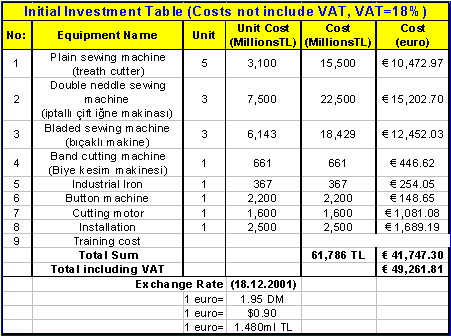 |
The evaluation of alternatives was done according to different criteria. While evaluating the advantages and disadvantages of the alternatives there was consideration of strengths, weaknesses, possible opportunities and threats (SWOT). For example, does alternative provide the job opportunities? If so, how many people can benefit from direct or indirect employment? Will the alternative provide independent source of income or at least operate at break-even point? In evaluation of alternative there was needed of consistency with Red Cross mission and strategies. The economic aspects such as initial investment cost, maintenance and operating costs were the other criteria during the evaluation, which are studied in the feasibility study part of the report. Hence, questions like who are beneficiaries, what needs do the project intended to meet, will be answered.
The light textile workshop is small shop producing such garment like T-shirts, caps, waistcoat (yelek), light coats (mont) and etc. One of the advantages is that job shop will provide job opportunities to about 10-15 people per shift without need for special formal education. The employees of shop could be from the most vulnerable families. The training of the employees will be done on the job.
During the evaluation of this alternative the assumption was that the employees would be paid with contemporary minimum wage rate of the labor market. Hence, the rest of the profit could be allocated to other activities of the branch by elevating financial burden and dependency on national society could be the other advantage.
Moreover, besides the providing the job opportunities the employee could be attracted to become the volunteers and members of the Red Cross. That is to say, the employees will be provided first aid training, disaster response program courses as part of job routine. There is hope that people who will benefit from this employment opportunity will understand the Red Cross mission and represent it throughout the society to improve the RC image. Propagating the mission of the Red Cross to their children, relatives, comrade and neighbors.
Despite the above stated advantages there are some disadvantages. One of the main challenges of this alternative is that it requires high initial investment in comparison with other alternatives. The purchase of necessary equipment is the main constituent of the investment.
The other challenge is that there is necessity for initial training of employees and trainers.
Which could only be done after the establishment of the job shop or training in similar facilities and machines somewhere else.
The other beneficial alternative is to expand the existing hospital capacity. In the hospital of the branch there could be established medium size dentistry employing one or two professional dentists. This alternative is intended to improve the health of the local people.
The primary advantage of this alternative is that it provides to vulnerable people a cheaper medical service in comparison with other local private dentistries. The only thing required from the patients is low cost contribution for operating the dentistry at break even. There was assumption that the average visit of patients per one dentist is the same as country average.
Besides providing the medical service, this alternative is compatible with Red Cross mission and strategies. Hence, it will improve the Red Cross mission in the society by improving the health of the people.
However, this alternative like workshop has also its drawbacks. The initial investment to dentistry equipment is very high. Moreover, maintaining the dentistry and employing professional and experienced dentist could be expensive. Provision of the medicaments is other expensive aspect in cost issues.
This alternative provides only little job opportunity to the local people. They could only be dentists or technicians.
First Aid training to local firms is the other alternative. Although alternative is intended to Red Cross members and volunteers, it will indirectly increase the disaster preparedness of the society.
The advantage is that it provides the job opportunity by providing charged First Aid training to local private firms. The firms could be ones which high risk of injuries such as construction firms, fire extinguishing, and manufacturing. The fees earned from the training could be used by branch for other activities.
Moreover, in contrast to other alternative this alternative requires no initial investment cost. Since the branch already has professionals and well trained Fir Aid teams.
The other advantage is that by providing the First Aid training to the employees of local firms the Red Cross can increase the disaster preparedness of the local society. That is to say the number of people that can provide First Aid to population will increase.
However, making agreement and
contracts with firms on service prices could not be easy. Since not all the
firms will continuously take training courses, or some may already have their
own training programs.
Feasibility study was an economic criterion in evaluation of alternatives. While the benefit-cost ratio was a tool used in the feasibility study of each alternative separately, the incremental benefit cost ratio was used in choosing the best alternative. The alternative was considered as feasible when the ratio was equal or greater than one.
The assumptions made on benefits and costs of each alternative are stated in the feasibility studies of each alternative. All the evaluations are done in euros.
The assumptions made here are as follows:
Ø The planning horizon taken is 10 years
Ø The taxes are not considered
Ø No insurance cost for each employee
Ø No facility rent or foundation cost (to be provided by RC)
Ø All the products can be sold (Marketing issue)
Ø MARR is interest % 3,3/year (Iş Yatırım, 18.12.2001)
Ø Exchange rates (Iş Bankası, 18.12.2001)
Ø Benefits are 10 employees working at minimum wage rate
Ø Minimum wage rate is around 125 million TL
The costs categories:
Equipment cost
Installation cost
Operating cost (electricity, heating and overhead cost)
Training cost
VAT (Value Added Tax)
The benefits category:
Employee salaries
The table below shows the initial investment table and benefit-cost ratio. Assuming the above stated assumptions the calculations resulted that alternative is feasible and beneficial.

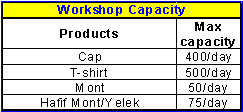
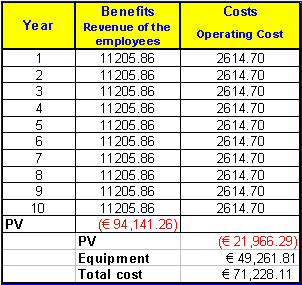
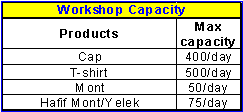
The assumptions made here are as follows:
Ø The planning horizon taken is 10 years
Ø The cost of equipment include VAT
Ø The taxes are not considered in wages
Ø No insurance cost
Ø No facility rent or foundation cost (to be provided by RC)
Ø MARR is interest % 3,3/year (Iş Yatırım, 18.12.2001)
Ø Exchange rates (Iş Bankası, 18.12.2001)
Ø Average monthly revenue is around 3 billion taken
to be the same as country average dentistry revenue
Ø The total monthly operating cost around 1.5 billion will be
maintained by patients served
Ø Benefit is revenue minus total operating cost
Ø Wage rate of one dentist is 1 billion TL (average dentist salary in Turkey)
is included in operating cost
The costs categories:
Equipment cost
Operating cost (electricity, heating and overhead cost)
VAT (Value Added Tax)
The benefits category:
Benefit to patients

The following tables show investment and benefit-cost ratios. Considering above
assumptions the alternative seems to be feasible and beneficial.
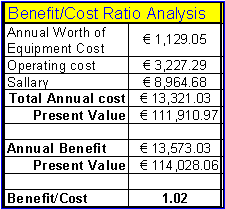
There is no need for calculation since there are no major costs in this alternative. The alternative from economic aspect is feasible. The benefits are wages and revenues earned from training services. At this stage the conclusion was that this alternative could be implemented together with other alternative.
Choice
of the most beneficial alternative:
At this stage of the project there was incremental benefit-cost ratio analysis among the alternatives. The alternatives considered are workshop and dentistry. The logic can be described as follows. Firstly, choose the cheapest alternative, and then find how much incremental cost is necessary to apply more expensive alternative. The incremental benefit is difference between the first and second alternative. The second alternative is considered to be more beneficial if the incremental benefit exceeds the incremental cost. The calculations are provided in the Appendix***. The results showed that the workshop seems to be more beneficial alternative.

The following table shows the incremental benefit cost analysis for workshop and
dentistry.
Textile industry is very large so product variety is very huge, which requires different configurations of the equipments for each type of products. The workshop that is proposed in the project is of the middle size enterprise operating independently but the stakeholder is Red Cross.
Three types of sewing machines will be employed there. With these machines and other general equipment like iron, cutting motors workshop can produce products like Mont, cap and others.
This activity needs 41,000 euro to be invested initially. Also it has operating and maintaining costs that are not so high compared to investment. Workshop will be able to employ 10 people on average. This number is not precise; number of employees can be increased up to 15. This depends on the demand for the products produced. The employees will be vulnerable people who need some kind of income. For the first period people should be taught some sewing skills. Hiring some professionals can do this. So for the first several months, facility will have low capacity, because workers need time to get familiar with their jobs. Later, workers’ performance will increase so that it can be able to compete in the market. Capacity of the workshop can be expanded if necessary. Sewing machines does not require a lot of space and buying them incrementally can widen the product range and will not greatly contribute to the overall cost.
In addition, when this activity will be successful sewing courses can be provided to other people to acquire profession. They then will be able to practice in the workshop.
Although workshop alternative seems to be beneficial there some issues to be considered to make alternative sustainable. Something said to be sustainable when it can continues its functioning without any or slight external support. In order o make workshop functioning the following can be suggested. First assign good manager to control the workshop activities, second effectively utilize the revenue earned and finally produced customized and qualitative products.
To maintain the proper functioning of the workshop the Red Cross should assign an entrepreneur. The manager will be in charge of running the whole workshop. He functions will be planning, organizing, leading and controlling. He should plan the material requirement, production plans. Moreover, he should organize training programs, organize an organization structure, and assign responsibilities. The manager should lead the employees by motivating them, create an ergonomic workplaces, and do job design. Finally, the manager should control the operating costs, inventory and transportation costs, try to minimize the cost as much as possible and suggest new ideas on modification of products and etc.
In addition to proper functioning, there is need for financial control by top-level management of the Red Cross. Responsible person from the Red Cross should tightly control the revenues and profits earned. He should be in charge of proper use of the profit by Red Cross branch. If necessary he should allocate required amount of money to expand the capacity or upgrade the machines, maintain proper functioning of machines and equipment.
The suggestion is to produce highly customized products and obtain loyal
customers. For example, the customers of this shop could be the rescue teams of
other organization, rescue teams of Red Cross. The can produce uniforms,
equipment with organization names, or required quality and design. Moreover,
product with Red Cross symbols could be sold local markets, in Red Cross fairs,
similar to card fairs of UNICEF or to donators and volunteers.
To summarize, the Red Cross Izmit Branch Capacity Development project was real project we studied so far in IE curriculum. The project was interesting and challenging where we could try to apply what we have learned in IE courses such as systems approach, SWOT analysis, Benefit-Cost analysis and etc.
The challenging part of the projects that in real life nothing is like what you plan or expect. Sometimes was need for situational decisions. The other hard part is communication with people involved and high wall of bureaucracy.
Prof. Dr. Erol SAYIN
Prof. Dr. Cağlar GÜVEN
Özgür Galip YAZIYURT-German Red Cross representative
Osman SARIÇAM- Head of İzmit Branch
FALCON Havacılık
Tekstil Şirketi, Ger-San sanayi sitesi,
Şaşmaz, ANKARA
Figenin
ablasi